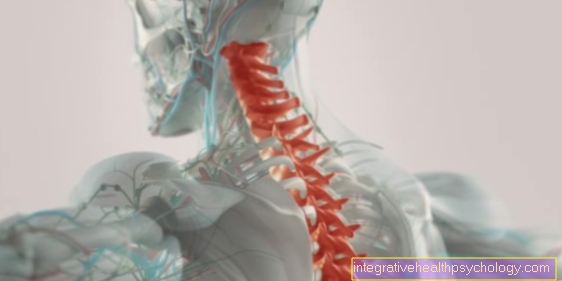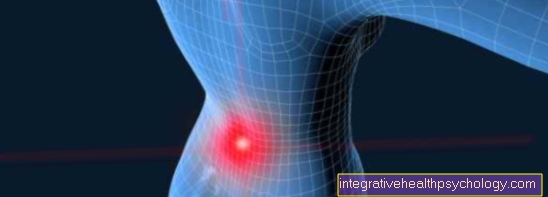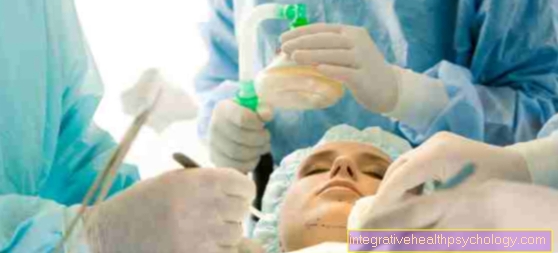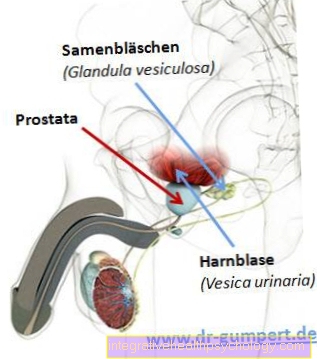Anatomy tooth
Synonyms
Teeth, tooth crown, tooth root, tooth enamel, gums
Medical: Dens
English: tooth
introduction

Anatomy is the science that deals with the shape and construction of the body and its parts. What applies to the whole human body can also be applied to its individual parts, including the tooth.
The tooth can be roughly divided into crown, neck and root.
Here you get to Dentistry.
Figure tooth

a - tooth crown - Corona dentis
b - tooth neck - Cervix dentis
c - tooth root - Radix dentis
- Tooth enamel -
Enamelum - Dentin (= dentine) -
Dentinum - Tooth pulp in the tooth cavity -
Pulp dentis in Cavitas dentis - Gums -
Gingiva - Root canal
- Cement -
Cementum - Root skin - Periodontium
- Opening of the tooth root tip -
Foramen apicale dentis - Nerve fibers
- Alveolar bone (tooth-bearing
Part of the jawbone) -
Pars alveolaris
(Alveolar process) - Blood vessels
- Tooth Root Tip -
Apex denitis - Point of division of the tooth roots
(Fork) - Bifurcation - Tooth furrow
You can find an overview of all Dr-Gumpert images at: medical illustrations
The tooth crown
A distinction is made between the visible and the invisible parts of the tooth. The visible part that stands above the gums and protrudes into the oral cavity is called the tooth crown. The outermost layer, so to speak the coating of the crown, is the enamel, it consists of Hydroxyapatite, an inorganic material that contains only 1-2% organic matter. Hydroxyapatite has a prismatic structure, which gives it a certain transparency.
Tooth enamel is the hardest substance in the body. Under the enamel is a second, much softer layer called dentin. The dentin or dentin is much softer than the enamel, but harder than bones and pervaded by fine dentin tubules in which the extensions of the bone-forming cell processes are located. Both layers are not supplied with blood. So they cannot be restored if the body is damaged.
The pulp is located right inside the tooth, pulp called. The pulp contains connective tissue, blood vessels and nerves and is connected to the entire organism. The shape of the pulp is roughly similar to that of the dentin. With age, the pulp shrinks due to the addition of secondary dentine.
Read more on the topic: Dental crown
The neck of the tooth

The part of the tooth between the crown and the root is called the tooth neck. This is the part of the tooth that is normally covered by the gums all around, at the transition from the tooth crown to the tooth root. The gum furrow is also located at this point (Sulcus), on which the bacterial deposits settle first and which is therefore particularly prone to tooth decay.
Also read Pain at the Tooth Neck
Read more on this topic: Tooth neck
Crown shape and number of roots
The individual teeth have different tasks in the preparation of the food (see also: Nutrition). The names are identical in the upper and lower jaw, so we have 4 wedge-shaped incisors for each half of the jaw (Incisivi), 2 canines each (Canini) 4 small molars each (Premolars) 4 molars (Molars). There are also 2 so-called wisdom teeth. The adult's permanent set of teeth comprises a total of 32 teeth. However, the number of roots is partly different in the upper and lower jaw. All incisors and canines have only one root in both halves of the jaw. In contrast, the first has in the upper jaw Premolar two and the second one root. The molars have three roots. In the lower jaw, the molars have only two roots. The number of roots in wisdom teeth can vary between one and four roots. The surfaces of the premolars and molars are equipped with cusps and grooves. This surface design promotes the chopping of the food. See also orthodontics.
The tooth root

The invisible part of the tooth is the tooth root, which is in the alveolus is located. It consists of dentin with a thin outer coating, the dental cement. Connective tissue fibers, the periodontal membrane (Periodontium) connect the cement to the bone and thus fix it in the alveolus. The periodontium is the fastening and hanging device that has to withstand the tremendous chewing pressure. A so-called root canal runs inside the tooth root, in which the blood vessels and nerve fibers from the pulp run to the end of the root, the apex, where they emerge and thus establish a connection with the entire organism. In the case of a single-rooted tooth, this is straight, while in the case of a multi-rooted tooth, the roots can be more or less slightly curved.
Read more on the topic: Tooth root
The milk teeth
The structure and shape of the deciduous dentition correspond to those of the permanent dentition. With the exception that the Premolars are missing, in their place are the Deciduous molars. There are also no wisdom teeth. Due to the lack of some teeth, the deciduous dentition consists only of 20 teeth. Of course they are Milk teeth much smaller and the individual layers of enamel and dentin much thinner, which makes them also more susceptible to Caries makes. The roots of the milk teeth are gradually reabsorbed until only the crown remains and the tooth fails to make room for the permanent tooth.

I - right upper jaw -
1st quadrant (11-18)
II - left upper jaw -
2nd quadrant (21-28)
III - lower jaw left -
3rd quadrant (31-38)
IV - lower jaw right -
4th quadrant (41-48)
- 1. Incisor -
Dens incisivus I - 2nd incisor -
Dens incisivus II - Canine tooth -
Dens caninus - 1st molar tooth
Anterior tooth (premolar) -
Dens premoralis I. - 2nd anterior molar
Anterior tooth (premolar) -
Dens premoralis II - 1st molar tooth -
Dens molaris I - 2nd molar tooth -
Dens molaris II - Wisdom tooth (= 3rd molar) -
Dens molaris tertius
(Dens serotinus)
1st - 3rd are front teeth
(3 per quadrant)
4th - 8th are molars
(5 per quadrant)
You can find an overview of all Dr-Gumpert images at: medical illustrations
The canine
The canine (lat. Dens caninus, „Dog tooth“) Is a cone-shaped one tooth in the denture behind the incisors and in front of the premolars (Premolars).
The designation as a canine refers to the clear kink of the dental arch at this point. In the upper jaw, the canine is the foremost tooth in the Maxillary bone (Maxilla). Humans have one canine tooth per half of the jaw in the upper and lower jaw, so a total of 4 canine teeth.
It is always in third position and is the largest tooth in the anterior region. The canines each form the transition from the Front teeth (Incisors) to the Posterior teeth (Molars). The canine is already in Milk teeth The first breakthrough occurs at around 1.5 years.
The eruption of the permanent canines takes place around the age of 11. Every canine has one Tooth rootwhich contains a channel. Some of these roots are somewhat flattened. The upper canines also have a distinct root feature with a curvature at their root tip.
Both features are absent in the lower canines. The roots of the lower canines are shorter, so here the Dental crowns slightly longer than the roots. Instead of a chewing surface, the crown of the canine only has a cusp tip (Canine tip) with two short cutting edges.
Unlike the incisors, the chewing surfaces of the canines are divided into two parts mesial (front) and one distal (rear) half. These halves form an angle of approx. 20° to each other. In addition, like almost all teeth, the canine has a slight curvature from the incisal edge to the tooth neck.
The cutting edge of the canines is less pointed than that of the incisors and is not exactly in the middle of the cutting edge, but is shifted a little forward. There is also a small difference between the upper and lower canines. The lower canines are usually slightly smaller than the upper ones.
The incisor
The Incisors (lat. Dentes incisivi) are used to bite off the food. They are located in the front area of the Jaws and the human has 4 incisors above and below.
That means two central and two side incisors above and below. The central incisors are in the Tooth formula with the numbers 11, 21, 31 and 41, the lateral incisors above and below with the numbers 12, 22, 32 and 42.
The canines border the incisors, which are also part of the "Front teeth" belong. The distinction between the individual permanent teeth in the denture takes place according to their position in the dentition and their function. The incisors, like any other tooth in human dentition, consist of one Dental crown, the Tooth neck and the Tooth root.
The tooth crown is rather flat and sharp-edged, depending on its task of biting off the food, which makes it easy to bite off. In addition, each tooth is made up of different layers, which are covered from the outside by the tooth enamel.
That lies inside Dentine (Dentin) which in turn is the Pulp (pulp) encloses. The tooth root is surrounded by dental cement up to the transition into the tooth neck.
Summary
The 32 teeth of the adult differ in the shape of the tooth crowns as well as the number of tooth roots, depending on their tasks in feeding and grinding. The tooth structure consists of three components, the tooth enamel, the dentin and the tooth pulp. The deciduous dentition comprises 20 teeth, the anatomy of which is identical to the permanent teeth, only in a smaller version.



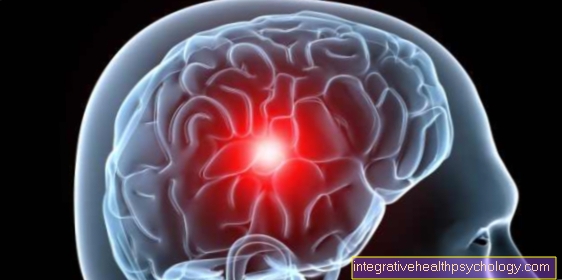
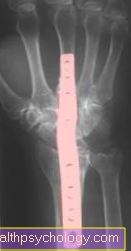
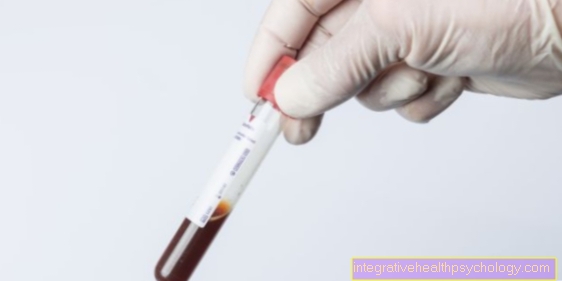
.jpg)


